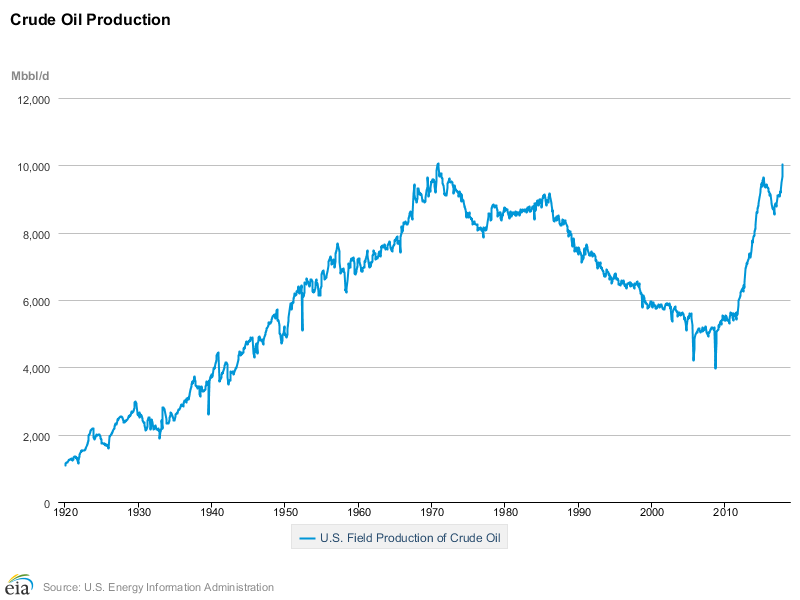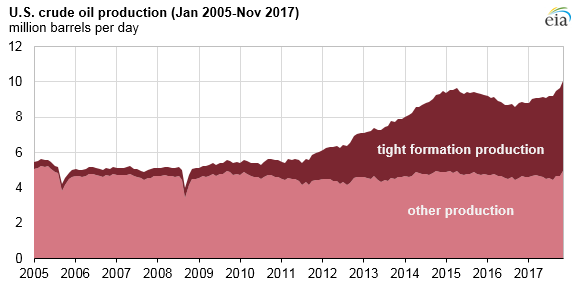The Meaning of 10.038 Million Barrels Per Day
Mark Green
Posted February 1, 2018
The U.S. Energy Information Administration (EIA) reports that in November, U.S. oil production hit 10.038 million barrels per day – the most in half a century. EIA’s graph:

Three big-picture takeaways from 10.038 million barrels of oil per day:
1. America is Stronger, Our Future is More Secure
Access to abundant energy supplies is essential for America’s security today and tomorrow. In a world that’s powered mostly by natural gas and oil now and will be for decades to come, plentiful domestic energy means falling imports, rising self-sufficiency, economic growth and greater strength for our country around the globe. The Wall Street Journal (subscription required) on lower crude imports:
As U.S. producers pump more, oil imports from foreign countries are shrinking to new lows and American crude exports are rising. The petroleum trade deficit in the U.S. was 2.5 million barrels a day at the end of the year when looking across all types of petroleum liquids, including fuels such as gasoline and diesel, [consulting firm] Rystad [Energy] said. That is down sharply from a peak petroleum deficit of 12.5 million barrels a day in [2005].
Oil historian Daniel Yergin told the New York Times:
“This is a 180-degree turn for the United States and the impacts are being felt around the world. This not only contributes to U.S. energy security but also contributes to world energy security by bringing new supplies to the world.”
2. Industry Technologies are Building a Better Future
Yergin is right. America’s brightening energy reality is an about-face from an era scarcity and uncertainty to one of abundance and stability. We can thank America’s vast natural gas and oil wealth and a modern, technologically advanced industry that is able to harness that wealth.
Shorter version: Hail shale!
EIA says crude oil production from shale and other tight-rock formations using hydraulic fracturing and horizontal drilling reached 5.09 million barrels per day in November, eclipsing the previous high of 4.7 million barrels per day in March 2015. Liquid production – oil and condensate – from tight rock accounts for about 51 percent of total U.S. production, EIA says:

The shale energy renaissance is driven by technology and innovation. Check the innovation section in API’s 2018 State of American Energy report. It only begins to capture the smart technologies and data-based analytics driving today’s production – production that’s precise, efficient and that can be done with a minimal surface footprint.
3. U.S. Energy: In It For the Long Haul
Because we’re not your daddy’s oil – we’re smart, resourceful, resilient and forward-focused – U.S. energy can help Americans power past the impossible and build a better, more prosperous future. Developments in global markets have borne this out. Three years of low prices spurred productivity improvements in the industry, helping to make the shale boom more resilient. The New York Times analysis:
After a painful shakeout in the industry … a steadier shale-drilling industry is arising, anchored by better-financed companies. … [T]he United States is becoming a dominant producer. It is able to outflank competitors in supplying growing global markets, particularly China and India, while slashing imports from the Middle East and North Africa.
The Times writes that a more stable global energy balance has developed “by the sheer force of [U.S.] production, the supremacy of its technology, and an unmatched pipeline, refinery and storage structure …”
Bottom line: U.S. energy is transformative. That’s what 10.038 million barrels of oil per day means.
About The Author
Mark Green joined API after a career in newspaper journalism, including 16 years as national editorial writer for The Oklahoman in the paper’s Washington bureau. Previously, Mark was a reporter, copy editor and sports editor at an assortment of newspapers. He earned his journalism degree from the University of Oklahoma and master’s in journalism and public affairs from American University. He and his wife Pamela have two grown children and six grandchildren.


